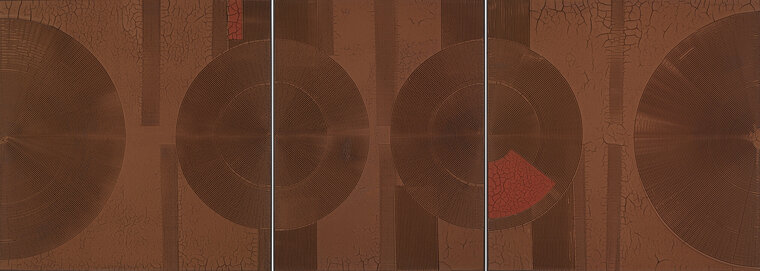In Tay al Ard, 2022, Moroccan artist Fatiha Zemmouri explores how the earth itself can tell a story. The title in Arabic (طي الأرض )that reads Tay al Ard translates to “folding the earth,” with the notion that the work explores how natural materials shift, break, and transform over time.
Zemmouri uses materials like clay, plaster, charcoal, and soil, both for their texture or color, and for what they represent. Clay and plaster come from the earth. Charcoal is what remains after fire. These elements carry traces of time, heat, and pressure. In her hands, they become tools to explore cycles of building and breaking down, of life, loss, and change.
The work does not directly depict a landscape, but it gives the impression of one – particularly that of the town of Tahanaout at the foot of the Atlas Mountains where Zemmouri lives. The cracks, folds, or rough surfaces look like the deep red dried soil or the mountain rock of the landscape that surrounds her. This direct link between material and place gives Zemmouri’s work a quiet power as it incorporates the land it reflects.
Zemmouri privileges the process: she does not force the materials into shape, but lets them respond naturally to time, air, and weight. Cracks form as the plaster dries, and textures emerge slowly on their own. While she has used fire in other works, here the transformation comes from more subtle but relentless forces: gravity, drying, and the quiet passage of time.
Zemmouri has said that she’s interested in the “in-between” spaces of what something was and what it is becoming. Whether it is a piece of clay turning to ash or a person going through a life shift, her art sits inside that quiet, uncertain space. Even though her work looks minimal, it is full of meaning. It’s about slowing down, noticing subtle changes, and thinking about how everything, from the land to our own lives, is constantly shifting.
Tay al Ard does not tell you what to feel; rather, it asks you to pause, look closely, and consider how things evolve, slowly, silently, and often under pressure. Like the earth itself, Zemmouri’s work holds memory in its layers.



-copy.jpg)
-copy.jpg)

